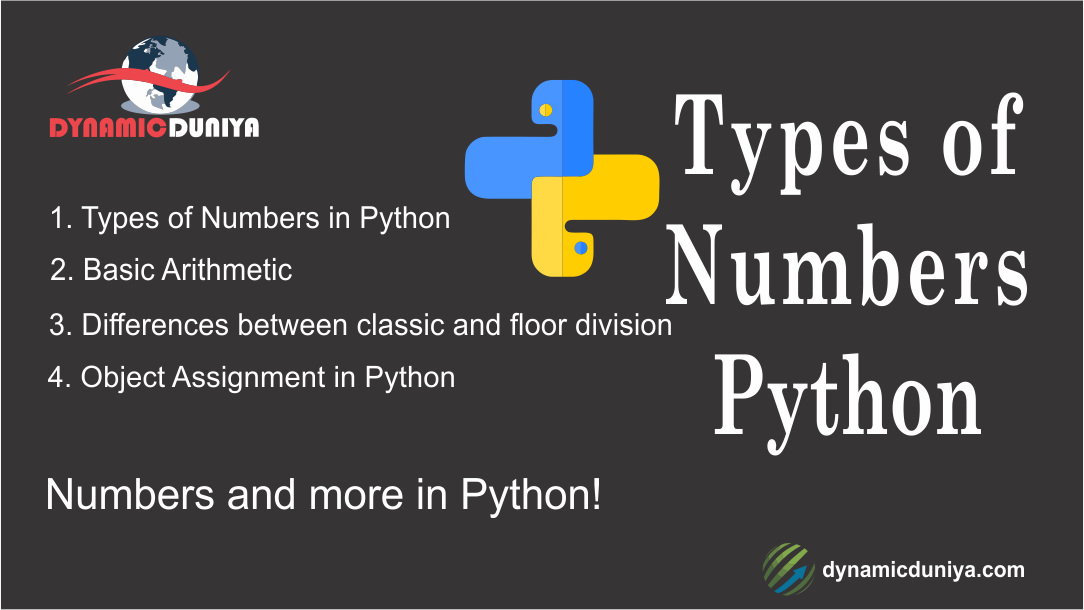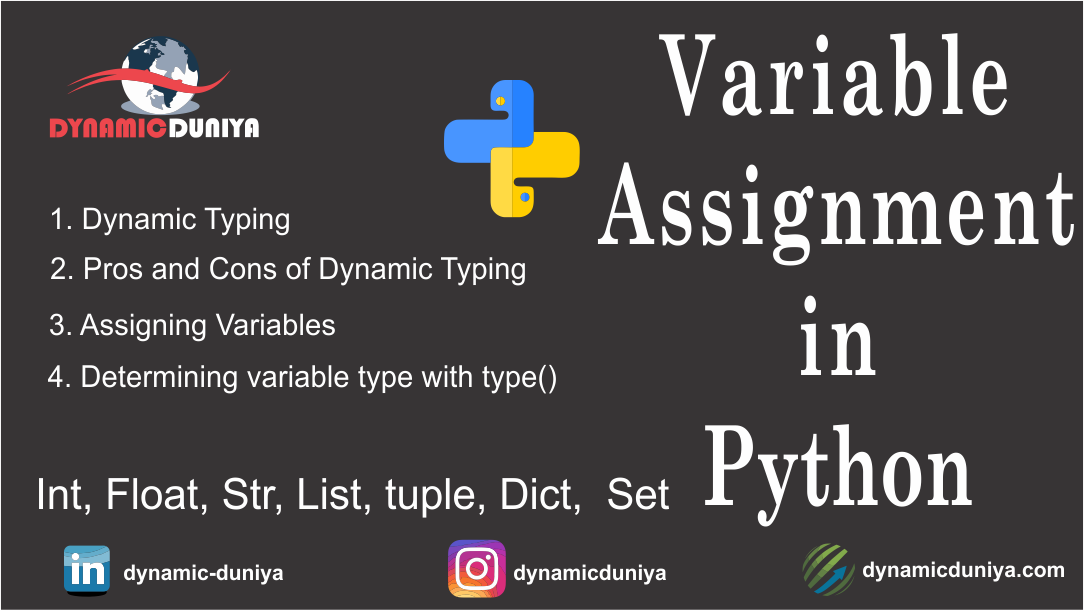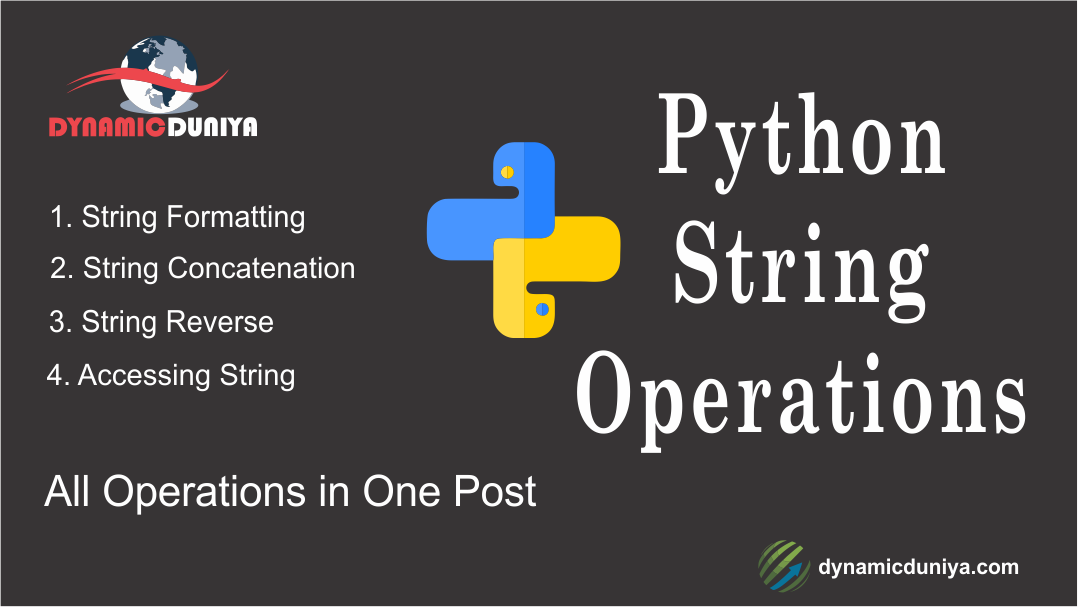Types of Numbers in Python

Python has various "types" of numbers (numeric literals). We'll mainly focus on integers and floating point numbers.
Integers are just whole numbers, positive or negative. For example: 2 and -2 are examples of integers.
In this lecture, we will learn about numbers in Python and how to use them.
We'll learn about the following topics:
- Types of Numbers in Python
- Basic Arithmetic
- Differences between classic division and floor division
- Object Assignment in Python
Types of Numbers
Python has various "types" of numbers (numeric literals). We'll mainly focus on integers and floating point numbers.
Integers are just whole numbers, positive or negative. For example: 2 and -2 are examples of integers.
Floating point numbers in Python are notable because they have a decimal point in them, or use an exponential (e) to define the number. For example 2.0 and -2.1 are examples of floating point numbers. 4E2 (4 times 10 to the power of 2) is also an example of a floating point number in Python.
Throughout this course we will be mainly working with integers or simple float number types.
Here is a table of the two main types we will spend most of our time working with some examples:
| Examples | Number "Type" |
|---|---|
| 1,2,-5,1000 | Integers |
| 1.2,-0.5,2e2,3E2 | Floating-point numbers |
Now let's start with some basic arithmetic.
Basic Arithmetic
# Addition
2+1
# Subtraction
2-1
# Multiplication
2*2
# Division
3/2
# Floor Division
7//4
# Modulo
7%4Arithmetic continued
# Powers
2**3
# Can also do roots this way
4**0.5
# Order of Operations followed in Python
2 + 10 * 10 + 3
# Can use parentheses to specify orders
(2+10) * (10+3)Variable Assignments
Now that we've seen how to use numbers in Python as a calculator let's see how we can assign names and create variables. We use a single equals sign to assign labels to variables. Let's see a few examples of how we can do this.
# Let's create an object called "a" and assign it the number 5
a = 5
#Now if I call a in my Python script, Python will treat it as the number 5.
# Adding the objects
a+aWhat happens on reassignment? Will Python let us write it over?
# Reassignment
a = 10
# Check
print(a)Yes! Python allows you to write over assigned variable names. We can also use the variables themselves when doing the reassignment. Here is an example of what I mean:
# Use A to redefine A
a = a + a
# Check
print(a)The names you use when creating these labels need to follow a few rules:
- Names can not start with a number.
- There can be no spaces in the name, use _ instead.
- Can't use any of these symbols :'",<>/?|\()!@#$%^&*~-+
- It's considered best practice (PEP8) that names are lowercase.
- Avoid using the characters 'l' (lowercase letter el), 'O' (uppercase letter oh), or 'I' (uppercase letter eye) as single character variable names.
- Avoid using words that have special meaning in Python like "list" and "str" Using variable names can be a very useful way to keep track of different variables in Python. For example:
# Use object names to keep better track of what's going on in your code!
my_income = 100
tax_rate = 0.1
my_taxes = my_income*tax_rate
# Show my taxes!
print(my_taxes)So what have we learned? We learned some of the basics of numbers in Python. We also learned how to do arithmetic and use Python as a basic calculator. We then wrapped it up with learning about Variable Assignment in Python.
Random Blogs
- Understanding Data Lake, Data Warehouse, Data Mart, and Data Lakehouse – And Why We Need Them
- Internet of Things (IoT) & AI – Smart Devices and AI Working Together
- Navigating AI Careers in 2025: Data Science, Machine Learning, Deep Learning, and More
- Where to Find Free Datasets for Your Next Machine Learning & Data Science Project
- The Beginner’s Guide to Normalization and Denormalization in Databases
- Deep Learning (DL): The Core of Modern AI
- Extract RGB Color From a Image Using CV2
- What is YII? and How to Install it?
- Understanding OLTP vs OLAP Databases: How SQL Handles Query Optimization
- Understanding SQL vs MySQL vs PostgreSQL vs MS SQL vs Oracle and Other Popular Databases
Prepare for Interview
- JavaScript Interview Questions for 1–2 Years Experience
- JavaScript Interview Questions for 0–1 Year Experience
- JavaScript Interview Questions For Fresher
- SQL Interview Questions for 5+ Years Experience
- SQL Interview Questions for 2–5 Years Experience
- SQL Interview Questions for 1–2 Years Experience
- SQL Interview Questions for 0–1 Year Experience
- SQL Interview Questions for Freshers
- Design Patterns in Python
- Dynamic Programming and Recursion in Python
- Trees and Graphs in Python
Datasets for Machine Learning
- Amazon Product Reviews Dataset
- Ozone Level Detection Dataset
- Bank Transaction Fraud Detection
- YouTube Trending Video Dataset (updated daily)
- Covid-19 Case Surveillance Public Use Dataset
- US Election 2020
- Forest Fires Dataset
- Mobile Robots Dataset
- Safety Helmet Detection
- All Space Missions from 1957
- OSIC Pulmonary Fibrosis Progression Dataset
- Wine Quality Dataset
- Google Audio Dataset
- Iris flower dataset
- Artificial Characters Dataset
- Bitcoin Heist Ransomware Address Dataset




